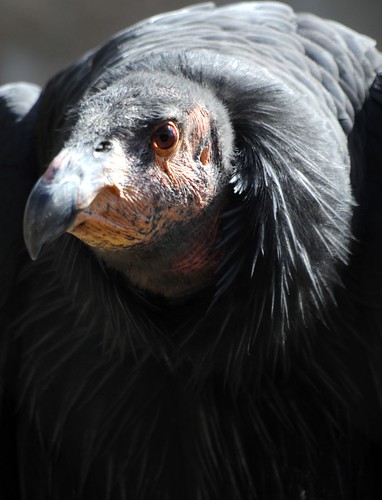
"There appears to have been a recent death," the man murmured nodding towards the heavy birds, which hopped about, utterly fearless.
"How so?" asked the second traveller.
"When a monk dies, his body is butchered and thrown to the wild animals. It is considered the highest honour to have your mortal remains nourish and sustain other living things."
"A peculiar custom."
'On the contrary, the logic is impeccable. Our customs are peculiar,"Preston/Child - The Wheel of Darkness

I've often thought, upon seeing a vulture, that perhaps it wouldn't be such a bad way to have one's self disposed of, though now it is hard in most places where this tradition has developed to find enough vultures to do the job. Vultures fascinate me; both in and of themselves and as representatives of wilderness. A land with vultures is a land untamed enough to contain large, unsanitised amounts of death and hence similar amounts of life. Last year, I went on a pilgrimage of sorts to the west coast of north america to search for giants. Giant trees, great whales and giant sharks. There was one more giant I sought. A restored relic; the Californian Condor.
Seeing them is pretty easy. At any one time several can be found at San Diego Wild Animal Parks "Condorminium" (yes, yes I know). Now normally captive birds wouldn't float my boat but these are rather special. At one time all California condors were captive birds, taken from the wild in a last gasp effort to save the species that thankfully was successful. As such a visit to one of the institutions that was instrumental in their survival seemed appropriate, even necessary, before heading off to quest for them in their wild and it was there that the photos accompanying this post were taken.
Seeing them is pretty easy. At any one time several can be found at San Diego Wild Animal Parks "Condorminium" (yes, yes I know). Now normally captive birds wouldn't float my boat but these are rather special. At one time all California condors were captive birds, taken from the wild in a last gasp effort to save the species that thankfully was successful. As such a visit to one of the institutions that was instrumental in their survival seemed appropriate, even necessary, before heading off to quest for them in their wild and it was there that the photos accompanying this post were taken.
The condors' decline was hastened in the 19th century by lead bullets, both those aimed at them and those eaten by them, and by habitat destruction and disturbance but it began long before. In the late Pleistocene Huge California condors soared across much of North America's skies alongside an even bigger scavenger; Merriam's Teratorn (Teratornis merriami). As the megafaunal corpses below them subsided so to did the teratorns and condors. Teratornis fell to extinction where the condors retreated to the Pacific coast where they could continue to feast on the one group of large mammals that remained; the beached corpses of whales, dolphins and seals.

In time, even the mighty Pacific's whales and seals began to fall to man's greed and the Condor's lost yet another food source. At the same time those that headed to farm lands were relentlessly persecuted and the end seemed nigh......and yet somehow, with our help, they endured. I could go into detail about the rescue effort but I won't; the best way to learn about it is to read John Moir's Return of the Condor which covers that long, winding road through ingenuity and politics, joy and despair, perfectly. It was that road that eventually led me to Big Sur, California in 2008 to search for condors above the mist-draped redwoods.

As we drove deeper into Big Sur, a pair of huge black shapes floated over a ridge and we halted the car in a desperate screech. Struggling to pick out any detail beyond their size at distance I convinced myself I was looking at a pair of California Condors and was absolutely elated. As the birds drifted slightly closer nagging doubts set in. Closer still I confirmed the doubts were right; I'd strung myself into misidentifying a pair of turkey vultures.....and yet strangely I didn't seem to care. I was still elated and after a while I realised something, my joy wasn't due to seeing condors, my joy was due to there still being a chance of seeing condors drifting through California's skies at all.

5 comments:
Congrats on the Condor sighting. I enjoyed your post and thanks for sharing.
What a beautiful ode to the Condor. Thank you for writing this.
Beautiful images! Stunning! These are magnificent birds.
They are sure ugly. I have never seen one before. Our vultures are Bald Eagles. Old Duffer http://oldduffersnaturecinema.blogspot.com
Thanks for the comments all! Old Duffer - they're only a little ugly when sat still, when flying they're glorious!
Post a Comment